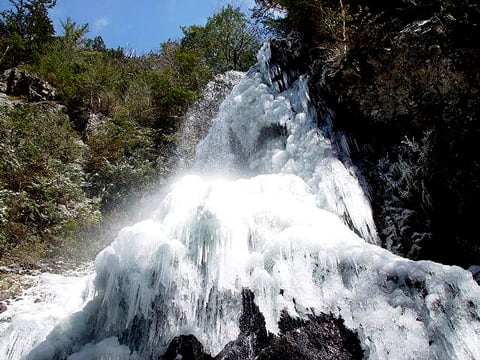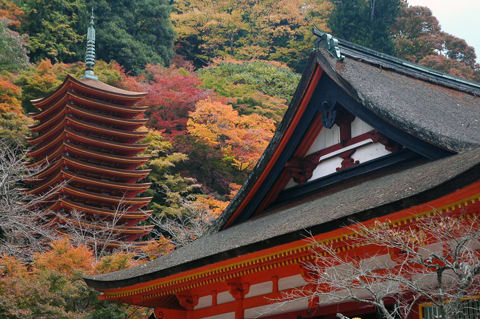※今日は英語で川上村[奈良県吉野郡]を紹介します。日本語版は末尾に掲載しています。
写真はすべて村の観光サイトから拝借しました。
Kawakami Village (Yoshino County, Nara Prefecture)
A two hours’ drive takes you to the center part of Kawakami Village from Nara City. This village exists in the southeast part of Nara Prefecture, and borders on Mie Prefecture at the eastern border. The area is 269 square kilometer, which is larger than Osaka City (223 square kilometer), but its population is only about 1,600 (as of February 2015).

It is at the upper reaches of Yoshino River (Kinokawa), where a beautiful man-made forest of Japanese cedar and hinoki cypress spreads over the steep slopes of V-shaped deep valleys. It has been the center of “Yoshino forestry” (Yoshino-style forestry) since old times. Yoshino forestry was designated as “Forestry Heritage” by the Japanese Forest Society in 2014.

Sako is the main settlement in the village, where there are the village office, the “Forest and Water Source Museum”, and Niukawakami Shrine (Kamisha). There is also an onsen (Yumori onsen) and “Hotel Suginoyu” run by the village.
There are historic sites concerning the Southern Dynasty in the period of the Northern and Southern Dynasties (1336-1392) such as Kongoji Temple and Jitenshinno (Imperial Prince Jiten) Shrine in the village, and “Morning worship ceremony” to worship articles left by the imperial prince is held on February 5 every year.

The Omine Mountains in the northern region are a part of the Yoshino-Kumano National Park. They are designated as a natural treasure by the country. In this area, there are Sannokogawa-Togasawara primeval forest and the Osako irrigation/ hydroelectric dam, and Shionoha hot spring is at the northern bank of the dam. Recently, Otaki dam was constructed downstream from it in Otaki in the village, and placed in service.

The National Route 169 (Higashi-kumano Highway) which runs along Yoshino River is used for transporting wood by truck, and Odaigahara Driveway connects Obamine Pass and Mt. Odaigahara. Specialty products are Hiuchi-mochi (mugwort rice cakes with bean jam, fried thin slices of dried mochi, thin noodles, dispensable chopsticks, sweetfish, dwarf rill trout and others. The Forest and Water Source Museum provides a popular tour called “Walking in the woods of the source of Yoshino River”, in which the participants walk along the Sannoko River to its source.
Access: Get off the train at “Yamato-kamiichi Station” of Kintetsu Yoshino Line. About 40 minutes from the station to Sako by Nara Kotsu Bus.
(translated by Yoshiko Fujiwara)
(日本語版)川上村(奈良県)川上村の中心部までは奈良市から車で約2時間。奈良県南東部にある村で、三重県と境を接する。面積は大阪市(約223平方㎞)より広い269平方㎞だが、人口は約1,600人(2015年2月現在)。吉野川(紀の川)の上流に位置し、深いV字谷の急斜面一体に、杉、檜(ひのき)の人工美林が広がる。古くから「吉野林業」(吉野式の林業形態)の中心地である。吉野林業は日本森林学会の「林業遺産」(2014年度)に認定された。
村の中心集落は迫(さこ)で、村役場や博物館「森と水の源流館」があり、丹生川上神社(上社)が鎮座する。温泉(湯盛温泉)が湧き、村営の「ホテル杉の湯」がある。
村内には金剛寺(こんごうじ)、自天親王(じてんしんのう)神社など、南北朝時代の南朝とゆかりの深い史跡が残り、毎年2月5日には、親王の遺品を拝する「朝拝式(ちょうはいしき)」が行われる。
北部の大峰山脈は吉野熊野国立公園の一部で、国指定の天然記念物。三之公(さんのこ)川トガサワラ原始林や灌漑・発電用の大迫(おおさこ)ダムなどがあり、ダム北岸には入之波(しおのは)温泉がある。近年、下流の同村大滝(おおたき)に大滝ダムが完成、供用を開始した。
吉野川に沿って走る国道169号(東熊野街道)は木材のトラック輸送に利用され、伯母峰峠(おばみねとうげ)から大台ヶ原山へは、大台ヶ原ドライブウェイが通じる。特産品は、火打餅(ひうちもち 餡の入った草餅)、揚げかきもち、そうめん、割り箸、アユ・アマゴなど。森と水の源流館による「吉野川源流の森を歩く」(三之公川を遡る)ツアーが人気を集める。
交通アクセス:近鉄吉野線「大和上市駅」下車。奈良交通バスに乗り換え、約40分で迫(さこ)に着く。
※素晴らしい自然と歴史遺産に囲まれた川上村には、せひ欧米など外国人観光客の皆さんにお訪ねいただきたい。(英訳は、藤原誉枝子さんにお願いしました。)
写真はすべて村の観光サイトから拝借しました。
Kawakami Village (Yoshino County, Nara Prefecture)
A two hours’ drive takes you to the center part of Kawakami Village from Nara City. This village exists in the southeast part of Nara Prefecture, and borders on Mie Prefecture at the eastern border. The area is 269 square kilometer, which is larger than Osaka City (223 square kilometer), but its population is only about 1,600 (as of February 2015).

It is at the upper reaches of Yoshino River (Kinokawa), where a beautiful man-made forest of Japanese cedar and hinoki cypress spreads over the steep slopes of V-shaped deep valleys. It has been the center of “Yoshino forestry” (Yoshino-style forestry) since old times. Yoshino forestry was designated as “Forestry Heritage” by the Japanese Forest Society in 2014.

Sako is the main settlement in the village, where there are the village office, the “Forest and Water Source Museum”, and Niukawakami Shrine (Kamisha). There is also an onsen (Yumori onsen) and “Hotel Suginoyu” run by the village.
There are historic sites concerning the Southern Dynasty in the period of the Northern and Southern Dynasties (1336-1392) such as Kongoji Temple and Jitenshinno (Imperial Prince Jiten) Shrine in the village, and “Morning worship ceremony” to worship articles left by the imperial prince is held on February 5 every year.

The Omine Mountains in the northern region are a part of the Yoshino-Kumano National Park. They are designated as a natural treasure by the country. In this area, there are Sannokogawa-Togasawara primeval forest and the Osako irrigation/ hydroelectric dam, and Shionoha hot spring is at the northern bank of the dam. Recently, Otaki dam was constructed downstream from it in Otaki in the village, and placed in service.

The National Route 169 (Higashi-kumano Highway) which runs along Yoshino River is used for transporting wood by truck, and Odaigahara Driveway connects Obamine Pass and Mt. Odaigahara. Specialty products are Hiuchi-mochi (mugwort rice cakes with bean jam, fried thin slices of dried mochi, thin noodles, dispensable chopsticks, sweetfish, dwarf rill trout and others. The Forest and Water Source Museum provides a popular tour called “Walking in the woods of the source of Yoshino River”, in which the participants walk along the Sannoko River to its source.
Access: Get off the train at “Yamato-kamiichi Station” of Kintetsu Yoshino Line. About 40 minutes from the station to Sako by Nara Kotsu Bus.
(translated by Yoshiko Fujiwara)
[美しき日本 Beautiful Japan] 奈良 Nara 川上村 Kawakami Village
(日本語版)川上村(奈良県)川上村の中心部までは奈良市から車で約2時間。奈良県南東部にある村で、三重県と境を接する。面積は大阪市(約223平方㎞)より広い269平方㎞だが、人口は約1,600人(2015年2月現在)。吉野川(紀の川)の上流に位置し、深いV字谷の急斜面一体に、杉、檜(ひのき)の人工美林が広がる。古くから「吉野林業」(吉野式の林業形態)の中心地である。吉野林業は日本森林学会の「林業遺産」(2014年度)に認定された。
村の中心集落は迫(さこ)で、村役場や博物館「森と水の源流館」があり、丹生川上神社(上社)が鎮座する。温泉(湯盛温泉)が湧き、村営の「ホテル杉の湯」がある。
村内には金剛寺(こんごうじ)、自天親王(じてんしんのう)神社など、南北朝時代の南朝とゆかりの深い史跡が残り、毎年2月5日には、親王の遺品を拝する「朝拝式(ちょうはいしき)」が行われる。
北部の大峰山脈は吉野熊野国立公園の一部で、国指定の天然記念物。三之公(さんのこ)川トガサワラ原始林や灌漑・発電用の大迫(おおさこ)ダムなどがあり、ダム北岸には入之波(しおのは)温泉がある。近年、下流の同村大滝(おおたき)に大滝ダムが完成、供用を開始した。
吉野川に沿って走る国道169号(東熊野街道)は木材のトラック輸送に利用され、伯母峰峠(おばみねとうげ)から大台ヶ原山へは、大台ヶ原ドライブウェイが通じる。特産品は、火打餅(ひうちもち 餡の入った草餅)、揚げかきもち、そうめん、割り箸、アユ・アマゴなど。森と水の源流館による「吉野川源流の森を歩く」(三之公川を遡る)ツアーが人気を集める。
交通アクセス:近鉄吉野線「大和上市駅」下車。奈良交通バスに乗り換え、約40分で迫(さこ)に着く。
※素晴らしい自然と歴史遺産に囲まれた川上村には、せひ欧米など外国人観光客の皆さんにお訪ねいただきたい。(英訳は、藤原誉枝子さんにお願いしました。)















































